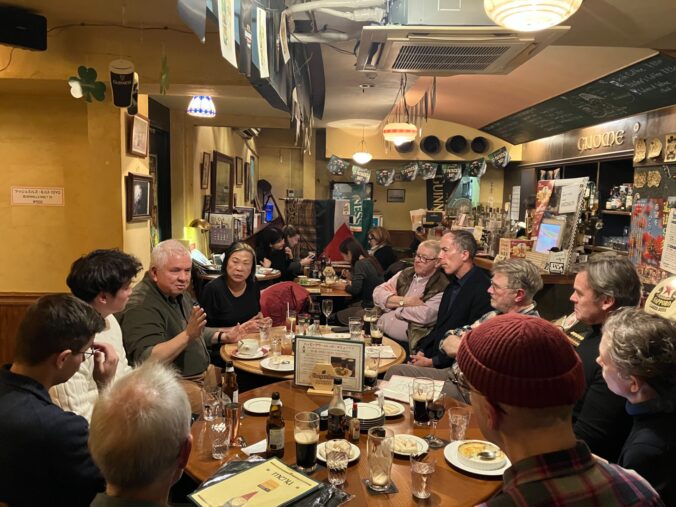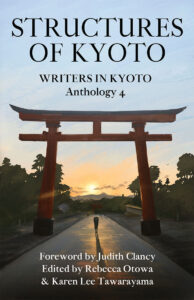A report on a Writers in Kyoto talk with the CEO of Tuttle Publishing.
Introduction
On Friday, November 29, Eric Oey CEO of Tuttle Publishing and Periplus Bookstores, visited Kyoto for an informal chat on the state of the publishing industry at The Gnome on Kawaramachi. About seven WiK members attended.
Tuttle is a family-owned and family-operated business, which was founded in 1948 by Charles E. Tuttle to help bridge the understanding between Asia and the West, which he saw becoming important in the post-war years. The first Tuttle bookstore was located inside the Takashima-ya department store in Nihonbashi, Tokyo. The bookstore was an immediate success among foreigners eager to learn more about Japan. Lines were long, and titles often sold out.
Charles Tuttle himself was a direct descendant of George Albert Tuttle, who founded a printing company in Rutland, Vermont in 1832. The company was sold some time after Charles’s death and passed out of family control.
But the book business runs deep in the Tuttle family DNA. While the Tuttle company was being managed by others, a Tuttle cousin named Eric Oey was independently building Periplus, his own empire of bookstores and bookstands, in Indonesia and Singapore. Periplus eventually became the leading bookstore chain in Indonesia, and successful enough to purchase Tuttle from its erstwhile owners, regaining family control and setting the stage for what one WiK member called a “miracle in motion.”
By global standards, Tuttle lies on the cusp between small and medium sized publishing firms, publishing about 100 new titles each year with a total staff of only 50 to 60 persons. But its near-dominant position in books on Asian literature, languages, and culture accords it an influence far above its nominal size.
Evidencing the fact that Tuttle / Periplus is definitely a family-run business, Eric was accompanied by his wife Christina and his son Matt, who also work in the firm. The family feeling was enhanced when Christina brought a bag of Indonesian shrimp chips to share with all the guests. Matt is also gearing up to produce a series of podcasts on serious intellectual issues in economics and political science.
The Publishing Business
Eric is quite optimistic about the prospects of the publishing business. Book sales increased by double digits during the COVID pandemic, and single-digit growth has continued since then. For many reasons, books do not face the challenges that have decimated newspaper and magazine publishing.
Even bookstores seem to be reviving. After Amazon went online in 1995 and began subsidizing its book sales in order to build volume, many brick-and-mortar stores could not compete, and were forced to close. The list of casualties included venerable institutions like Stacey’s in San Francisco, as well as major chains like Borders, which was heavily leveraged into real estate and forced to file for Chapter 11 when real estate prices collapsed in the financial crisis of 2007/2008.
In terms of the general market for books, the e-book situation is worth paying attention to. Roughly 10% of book sales are e-books, but their market share does not appear to be increasing. Originally, e-books were priced much lower than paper copies, and sales jumped. But as the price gap narrowed to just a few dollars, and publication dates became essentially simultaneous, the advantages of the paper copy re-asserted themselves, and e-book sales plummeted.
Only a small percentage of the overall population read books frequently, but they tend to be highly committed, and are unlikely to leave a good bookstore empty-handed. Consequently, most book sales still happen via bookstores. Amazon accounts for only about one third of total book sales. The importance of the browsing experience is a key reason that bookstores have been making a comeback, in the form of modest but well-curated collections designed to enhance the browsing experience.
No online platform can yet match the feeling of being on a “treasure hunt” one gets while scanning the shelves for some previously undiscovered must-read item. Readers seeking a specific book, or something within a narrowly defined specialty area, are more likely to go online.
Small bookstores get a boost in their efforts from an unusual business practice in the industry — any and all books can be returned to the publisher if they don’t sell. The practice was initiated during times when books were hard to sell, as a way of encouraging bookstores to take more risks with their inventory, and that benefit continues to accrue, especially to small stores with limited access to capital.
Barnes and Noble is actually doing well under new CEO James Daunt, who came along from Waterstones in the merger of the two firms. New stores are being opened, and other well-known British chains, like Blackwell’s and Foyle’s, have been brought into the fold.
Meanwhile, Amazon is a “disruptor” in the truest sense of the word. It sells e-books at a loss, while paper titles, along with the rest of its merchandise, barely break even. Economically speaking, one could make the case that the entire company has evolved simply to build scale for its cloud-services platform AWS, which accounts for most of the company’s profits despite representing only a modest fraction of its revenues.
The Publishing Business in Asia
Tuttle is currently getting a boost from the fact that interest in Asia is increasing. Specific authors like Murakami have triggered such interest that Tuttle has brought out a series of manga based on Murakami’s stories. Korea has also become a hot topic area, in which Tuttle is well positioned.
A glance at the Tuttle catalog also demonstrates significant innovation in terms of what constitutes a “book,” as tie-ins like origami paper and coloring books are also well-represented.
Advice for Authors
Poetry, history, fiction huge now, Eric noted. In poetry, however, it’s the very well established poets who are getting attention, while younger, less-established poets continue to have challenges. As one member of the audience remarked, “Poetry is hot, but you need to be a dead poet.” Not very actionable advice for those of us who are still among the living!
The use of photos or other illustrations in a book remains a thorny issue. There seems to be an inherent bias in the West, and particularly in the English language market, that a book with illustrations is not quite a serious book, which means that sales to a certain core of the market are likely to be impeded. This bias, however, does not seem to be an issue for the rest of the world.
Within the realm of what an individual author can do to help boost their publication, the role of “influencers” needs to be carefully considered. Influencers, by definition, are media or online personalities whose recommendations are highly leveraged. Personality types vary across the spectrum, from Oprah to Joe Rogan, to specialists like financial podcaster Patrick Boyle. Rogan himself provided Tuttle with a vivid illustration of influencer power when he happened to mention Tuttle’s Japanese Death Poems in one of his podcasts, causing sales to spike immediately.
Influencers need to be courted, and the first step is finding out who they are. Going online and following the social media threads that are relevant to your topic is a good way to start. Once you start to indicate a targeted interest by interacting with posts on those threads, the algorithms will start to pick up on your area of focus and feed you more. Eventually, you will get a sense of which commentators matter — who is listened to, and who is respected.
Follow the influencers you wish to influence. Compliment them (knowledgeably, of course!) and send them review copies. Don’t be afraid to make the “ask” for an endorsement if you think it is reasonable.
The task of placing reviews follows a similar pattern. Identify the journals, magazines, and other periodicals where you would like to see a review. Learn about the reviewers, and make sure to send a review copy.
Once your book is published, make friends with the bookstore staff at any stores in your area. Tuttle’s experience is that shelf placement is a key factor in determining a book’s success. Good relationships with the bookstore staff will help you ensure effective placement.
When pitching a your book, it’s worth noting that publishers are always on the lookout for new book ideas. About half of Tuttle’s new titles every year come from proposals presented by authors whom Tuttle has not published before. But you may need to do some homework to present a convincing “business case.”
Start with a Title Information Sheet, which summarizes all the important information a publisher will want to know about your concept — title, author(s), short bio, synopsis, estimated page count, and anything you can say about sales potential.
How do you gauge sales potential? Make a list of a few established titles that are close enough to provide a basis for comparison, and determine the Amazon Best Seller Rank (BSR) for those titles. The BSR can be found in the details section of any Amazon listing. The overall BSR tracks a title against all books. A lower number indicates a more successful title, but don’t be surprised at numbers in the 100’s of thousands or even millions. Amazon will also typically provide BSR’s for one or more topic areas (e.g. “Japanese poetry”) which tend to be much smaller, and more accurate predictors of relative success within your chosen category.
Interpretation of the BSR is complicated, however — it is not a simple cumulative tally. Amazon applies its own analytic model in determining the BSR, and tracks each format (e.g. hardcover vs. trade paperback vs. mass-market paperback) separately. Recent sales are also overweighted. But at least you have a start in benchmarking the potential of your book.







Recent Comments